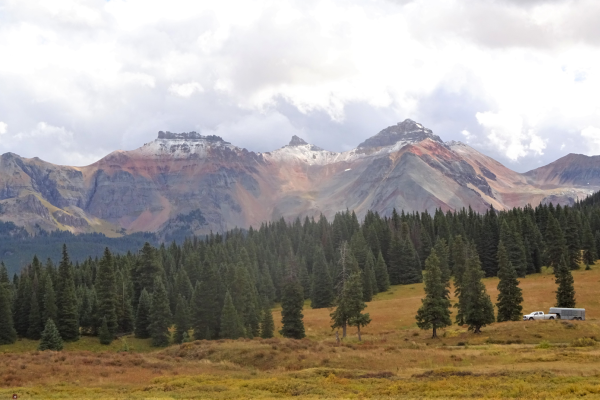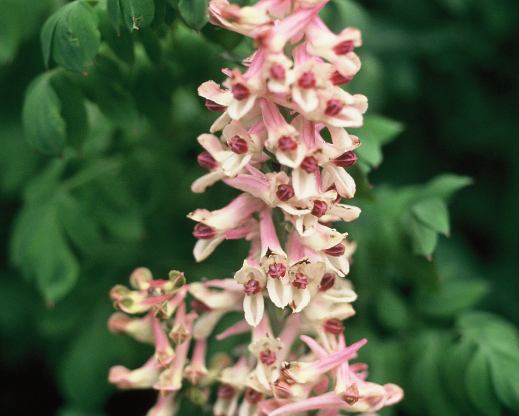Right around this beautiful town, you can botanize in sagebrush prairies akin to eastern Washington’s Palouse, sharing most genera and even many species with this biome nearly 1000 miles to the north and west. Not far from Durango, in Canyon Country, you can find flora reminiscent of California chaparral including manzanitas, zauschnerias, Penstemon rostriflorus, even California redbud. Grassy prairies not far from town resemble the Great Plains in floral makeup.
This part of Colorado is also the only place in the state where a number of eastern wildflowers have disjunct populations. Aralia racemosa and Trautvetteria caroliniensis, both common in the Alleghenies, are showy links to the eastern American woodland flora here, as is the eastern maidenhair fern (Adiantum pedatum var. pedatum) which for most of the last century was only known in one canyon on the million dollar highway from Ouray to Durango.
As for the boreal north, the San Juan mountains are the largest, most extensive high mountain complex of the southern Rockies, comprising tens of thousands of acres of alpine tundra filled with Arctic flora.
The dry steppe and pygmy forest around Durango possess many of the northernmost elements of the Mexican madrean flora, southwestern white pine (Pinus strobiformis) being a spectacular case in point. I can think of no spot that combines the vegetational extremes of America’s cardinal points more succinctly or elegantly.
I recall one of my many forays with T. Paul Maslin, a retired professor of biology at the University of Colorado, which took us to southwestern Colorado to explore and botanize. We stopped to picnic en route on top of Wolf Creek Pass and stumbled on the disjunct population of Corydalis caseana subsp. brandegeei which I believe is the largest species is this enormous genus. Some of the specimens we found there were over five feet (1.5 m) tall with thick clusters of ivory and pink spurred flowers.
In vacant lots around Pagosa Springs, we found masses of Phlox caryophylla, a highly localized brilliant pink phlox that has yet to become established in cultivation. I remember my shock in one deep canyon in Archuleta County finding a cliff-face festooned with the circumboreal sub-Arctic parsley fern (Cryptogramma stelleri) which is known only from a few collections far to the north in Colorado, and generally distributed far to the north in Eurasia. I believe our specimens are still the southernmost known for this fern in North America, if not the world.
Townsendia has always been one of my favorite genera, and southwestern Colorado boasts one of the finest, the endemic Townsendia glabella, which forms dense mats a foot across and sometimes mounds up like a Patagonian cushion plant. It is not uncommon near Durango, even growing on roadsides, but found nowhere else. The local silver-leaved form of Penstemon linarioides has even been championed by Plant Select, unfortunately with the cultivar name ‘Silverton’ (a town where it doesn’t grow). It should have been named for the other end of the narrow gauge railroad, ‘Durango’, where it’s abundant.
There is no end of unusual, endemic, and obscure wildflowers in this area, many of them quite spectacular, tucked here or there from the lowest, driest near-desert areas to the highest alpine tundra. But the grand floral displays this area offers are what most visitors find dazzling. Mid-June is usually peak bloom for penstemons, buckwheats, and many composites that comprise some of the showiest elements of the pinyon-juniper forest that dominates Mesa Verde. I have visited this fantastic national park many times. No matter how many times I visit, there is always more to see, studded as it is with so many fantastic archaeological monuments from prehistoric times. The park will be included on many of the tours, but should you choose other hikes, be sure to come early or stay after and explore Mesa Verde, Hovenweep, or Canyon of the Ancients—three of the most extraordinary concentrations of First People’s monumental architecture north of Mexico, and all an easy drive from Durango.
In the montane and alpine meadows of the San Juan Mountains (which comprise an agglomeration of smaller ranges such as the La Plata or La Garita mountains, any of which dwarf the mountains in any other state of the US except perhaps Alaska) the monsoonal rainfall pattern extends the flowery season throughout the summer months, but June is the peak of early bloom which includes the widest variety of flowers at all elevations. Fields full of paintbrush and daisies of all kinds bloom prodigally. Colorado columbine (Aquilegia coerulea) moves out from aspen groves and can dominate whole meadows at tree line and above with their enormous, waving flower clusters and sweet, lavender-like fragrance. This is the time of year to come and see vast pools of limpid azure wild iris (Iris missouriensis) filling the valley floors—pools that become whole seas of color in South Park this time of year. You are guaranteed to find wide mats of carpeting Penstemon crandallii in blue, and fragrant creeping phlox in white or pink just about anywhere sagebrush reigns in the middle elevations in June. And this is when glacier lilies (Erythronium grandiflorum) throng Kebler Pass en route to Durango from Denver, one of the great spectacles of the Rocky Mountain flora. Trollius albiflorus and Caltha leptosepala fill every subalpine freshet throughout the state this time of year and a bevy of tiny mertensias (a half dozen species or more) can be found in all the lowland steppe. Southwestern Colorado boasts Ranunculus macauleyi, one of the finest alpine buttercups, abundant in moist meadows at higher elevations here. Honestly, you have to come see it to truly believe it.
References:
https://www.swcoloradowildflowers.com/ is a wonderful website with a wealth of lovely pictures, keys, and tools concentrating on the flora of this area. It even boasts an app for plant identification for your phone. It also contains a wealth of valuable links and information. This website will be adequate for many participants’ basic needs, and it’s free.
In Intermountain Flora, the authors state that the “Canyonlands section is by far the richest area for endemics in the Intermountain Region” (Volume I, p. 104). This monumental multi-volume flora is not practical as a field guide I’m afraid, but it is a treasure trove of information for the entire west central quadrant of the United States from Durango westward. Definitely worth browsing in a nearby library if you don’t own a copy, but we don’t suggest lugging this along.
The definitive floristic monograph of the Durango area is Flora of the Four Corners Region: Vascular Plants of the San Juan River Drainage: Arizona, Colorado, New Mexico, and Utah (Monographs in Systematic Botany from the Missouri Botanical Garden) by Kenneth Heil, published in 2013. It is available new for about $70 and is definitive, gorgeous, and extremely heavy. Not useful for lugging out into the field, but it is the local botanical bible.
There are a dozen or more compact, handy volumes sold at bookshops in Durango and often at the excellent nurseries there and in Cortez. You may want to wait and pick them up at one of these. I recuse myself from recommending Wildflowers of the Rocky Mountain Region published by Timber Press since I’m one of the authors (ahem), but it also applies from New Mexico to Alberta as well.
Durango: Where The Four Corners Of America’s Flora Meet

January 1, 2021
OF COURSE, EVERY spot on Planet Earth is special, but one could argue that Durango and its setting is the biological ground zero of the United States, if not North America. Elements from far points of the compass seem to meet here.

